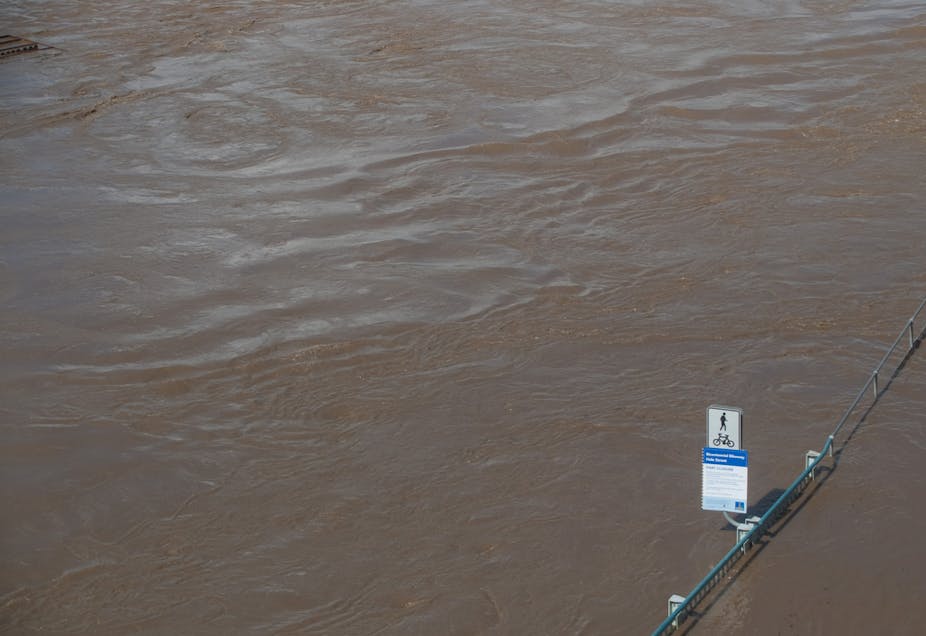While most people now understand that the enhanced greenhouse effect means a much warmer planet, communicating regional shifts in weather remains a significant challenge.
As with most complex science, nuance is everything. But how do you communicate complexity and nuance in a world increasingly geared to a 140-character limit? This is part two of a series looking at the relationship between climate change and rainfall. Part one is here.
I thought the drought was due to climate change?
The issue of recent rainfall trends, what caused them, and future rainfall projections has become very conflated in the public discourse.
Perhaps the first place to start to untangle this is to isolate the recent rainfall trends that are the most significant.
The most notable trends are the reduction in rainfall during the cooler months of the year across southern Australia; and increases in summer, monsoon rainfall across northern Australia.
These two changes have happened concurrently. Increases in tropical northern rainfall have more than offset winter decreases across southern regions, such that rainfall averaged over the whole continent is increasing. It has also been dry, on average, over Eastern Australia during the last few decades — particularly south-east Queensland and the southern Murray Darling Basin – the last two years of heavy rainfall notwithstanding.
The high, natural rainfall variability in Australia makes determining any rainfall trends a difficult job. In fact, the apparent trends in rainfall over most parts of the continent, including the recent heavier summer monsoon, are not statistically distinguishable from the background of highly variable, decade-to-decade and year-to-year rainfall changes.
However one important rainfall trend does stand out. The reduction in winter rainfall over southwest Western Australia is a clear trend in the observational data. Similarly, the loss of late autumn and early winter rainfall over the southeast of the continent is also notable, but less statistically significant than the reduction in the west.
And it is here that we can zero in on the changes that the scientists have been mostly concerned with, and have mostly been talking about.

Changes to autumn and winter rainfall in the Mediterranean climate regions of Australia can have large impacts. Typically, these regions receive the largest chunk of their annual rainfall during this period. This is delivered by cold fronts and storms that sweep across the coast from the Southern Ocean from April through to November.
The massive temperate forests and open woodlands found in both the southwest and southeast corners of the Australian mainland are evidence that cool season rainfall in these regions has been historically high and relatively reliable, over a very long period of time. Over the last 200 years, the rainfall has also supported some of our most significant agricultural areas. The natural water supplies of Perth, Adelaide and Melbourne are also highly dependent on rainfall during autumn, winter and spring.
However something significant happened to rainfall in the southwest of Australia in the second half of the twentieth century. The observational data shows a sustained 10-20% drop in winter time rainfall, starting in the late 1960s. Two decades later, a similar sustained reduction in rainfall occurred during autumn and winter in the southeast. This represents a significant change in the seasonality of southern Australian rainfall. Drying during the regular growing season is now apparent across large tracts of the southern agricultural zones.
The causes of this reduction in autumn and winter rainfall are an area of active research. Nonetheless, there is certainly evidence that the long-term drying is not just natural variability. Research conducted to date has shown that certain aspects of the rainfall changes are consistent with an enhanced greenhouse effect.
Research at the Bureau of Meteorology and CSIRO has shown that the rainfall reductions are due to changes in atmospheric circulation during the winter half of the year. In southwest Western Australia, the drying has been associated with reduced rainfall from storm systems and fewer storm systems in general.
These changes are consistent with higher atmospheric pressure that has been measured over the region. Studies have shown that aspects of these changes are, in turn, consistent with greenhouse gas increases, and decreases in stratospheric ozone in the Southern Hemisphere.

A simple lay person explanation is that global warming pushes storms that track across southern Australia even further south — towards the poles — as the planet heats up. It’s a bit more complicated than that, the temperature gradient between the warm equatorial and cool polar regions ‘fuels’ mid-latitude storm systems. Global warming changes the strength and position of this gradient, which leads to a change in the mean position of the storms. The rain is still falling, but its falling out over the Southern Ocean. It is reasonable to think of this as the tropics expanding and temperate regions moving poleward.
If this is the mechanism at play, then you might expect the changes to have occurred in the southwest earlier than the southeast. Since it lies further to the north, a southward shift of the storm systems should affect Western Australia before the southeast — and this is indeed what we observe.
We have now had 40 years of lower winter rainfall in the southwest. During 2010, with the rest of the country awash with water, southwest Western Australia experienced its driest year on record. The last decent wet year in the southwest was in 1965, and such years were fairly common in the preceding six-and-a-half decades of rainfall observations.
It is important to note here that even in the southeast, the heavy rainfall of the last two years has fallen outside of the autumn and winter period. The rainfall was tropical in origin, and generally associated with La Niña – in fact the 2010-11 event was one of the strongest La Niña’s of the past century. The bulk of what fell was out-of-season rainfall, and not the typical southeast rainfall delivered by winter-time cold fronts and storms.
Indeed, between the La Niña event of 2010 and the weaker event of 2011, late autumn and early winter rainfall returned to below average, continuing a trend that has lasted for more than 15 years. It is this trend that climatologists have been following, and it continued through the last two La Niña years.

It is inevitable that a wetter-than-average autumn or winter will occur again in future, but a single wet season is unlikely to have climate scientists revising their conclusions. It’s the long-term trend that is important.
The reduction of rainfall during autumn and early winter has significant hydrological and agricultural impacts. Heavy rainfall in spring and summer might help recharge reservoirs, but it is not necessarily helpful to grain growers. In addition, we can’t rely on these Mediterranean climates getting consistent heavy rainfall over the summer months without the help of La Niña.
Was the recent heavy rainfall due to climate change?
Attributing recent extreme events to climate change is a difficult, but emerging, part of the science. It’s also an emerging piece of evidence: extreme climate events are increasing all over the world.
Rainfall over 2010 and 2011 was the highest on record for Australia, beating the previous record for a two-year stretch in 1973 and 1974. A double La Niña event has been associated with both records, highlighting the role of natural variability in driving the heavy rainfall.
However, climate scientists have noted that some of the background conditions for the recent rainfall were consistent with expectations in a warmer world. Most notably, sea surface temperatures around Australia have been the warmest on record over the past two years. We know from the science behind seasonal rainfall prediction that elevated local sea surface temperatures are a key driver of above average rainfall for Australia, not just through the increased atmospheric moisture that they provide, but also — most importantly — due to the way they change local atmospheric circulation.

Scientists over the next decade, will explore the role of elevated ocean temperatures on the record rainfall of 2010 and 2011 in closer detail.
So what on Earth (or twin Earth) are we to make of all this?
Recent rainfall trends observed across Australia are, in many ways, consistent with a warming world; that is, decreases in southern Australian winter season rainfall, and increases in the tropical monsoon.
The severity of the drought, followed by the record breaking summer rainfall, is also consistent with projections for a warmer world.
In saying that, the big proviso here is that scientists have been careful not to overstate this case, and in releases such as the recent State of the Climate report, BoM and CSIRO highlight that we are still researching these issues.
The most consistent feature of modelling studies shows a likely future drying over southern and parts of eastern Australia, and less conclusive projections elsewhere. It is important to remember that these are projections for 2030 and 2050, and we should not necessarily expect to see such changes clearly right now, unless climate change is progressing more rapidly than the climate models have shown.

However we can use recent events as a heuristic for future climate change in a sensible and reasoned manner. We know that warming due to increasing greenhouse gases will change future rainfall patterns. We know that there is uncertainty in that, but that this uncertainty – coupled with the speed of changes to the climate system – serves to increase the risk in many regions.
Hence we can legitimately ask questions as to what we might do if recent, long-term rainfall changes turn out to be permanent.
Within this context, climate scientists have pointed out that the rainfall declines across the south have some consistency with what we would expect due to global warming. We also point out that the changes in the southwest have been very long lived. It is pertinent to draw the link between more recent rainfall reductions across the southeast, and the longer-term declines in the southwest.
It’s too early to make a definitive call on all of those issues, and another ten years of data will provide more concrete evidence. But the scientists’ job is to brief people, including the primary industry sector, water managers and ecologists, on what the best available current data and science is showing.
The experience of the Bureau of Meteorology has been that these science stakeholders are coming to understand the complex nature of the challenges that they are planning for, and are increasingly sophisticated users of climate information. That’s good news.
Tomorrow James Risbey from CSIRO explains how greenhouse climate change expresses itself through the natural modes of the climate system and what that implies in assessing the evidence of runs of wet and dry years.

